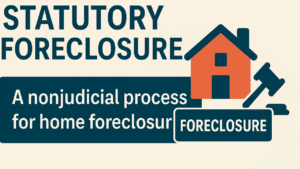 Understanding Statutory Foreclosure: A Fast-Track Path to Home Repossession
Understanding Statutory Foreclosure: A Fast-Track Path to Home Repossession
Keywords: statutory foreclosure, nonjudicial foreclosure, home foreclosure process, power of sale, foreclosure laws, real estate, mortgage default
Foreclosure is one of the most daunting experiences a homeowner can face. When mortgage payments fall behind, lenders have the legal right to reclaim the property. But not all foreclosures follow the same path. One lesser-known but widely used method is statutory foreclosure, also called nonjudicial foreclosure. This process allows lenders to foreclose on a home without going through the court system—provided certain legal conditions are met.
In this post, we’ll break down what statutory foreclosure is, how it works, and what homeowners need to know to protect themselves. Whether you’re a real estate professional, a homeowner, or simply curious about foreclosure laws, this guide will help you understand the essentials.
📘 What Is Statutory Foreclosure?
Statutory foreclosure is a nonjudicial process governed by state law. Unlike judicial foreclosure, which requires a lawsuit and court approval, statutory foreclosure allows lenders to reclaim a property without filing a case in court. This is possible only if the mortgage or deed of trust includes a “power of sale” clause, which authorizes the lender or trustee to sell the property in the event of default.
This method is faster, less expensive, and more streamlined than judicial foreclosure—but it also comes with strict procedural requirements to ensure fairness.
⚖️ How Statutory Foreclosure Works
Here’s a step-by-step overview of the statutory foreclosure process:
1. Default Occurs
The process begins when a borrower fails to make mortgage payments. After a grace period, the lender may issue a Notice of Default, informing the borrower of the delinquency and the risk of foreclosure.
2. Notice of Sale
If the borrower doesn’t cure the default (by paying the overdue amount), the lender issues a Notice of Sale. This document announces the date, time, and location of the foreclosure auction. It must be publicly posted and often published in local newspapers.
3. Public Auction
On the scheduled date, the property is sold at a public auction to the highest bidder. The winning bidder receives a trustee’s deed, transferring ownership of the property.
4. Eviction (if necessary)
If the previous homeowner hasn’t vacated the property, the new owner may initiate eviction proceedings.
🏠 States That Use Statutory Foreclosure
Statutory foreclosure is common in states that use deeds of trust rather than traditional mortgages. These include:
- California
- Texas
- Arizona
- Nevada
- Georgia
- Washington
Each state has its own timeline and notice requirements, so it’s crucial to consult local laws or a real estate attorney for specifics.
Note for Florida Residents: Florida does not use statutory foreclosure. Instead, it follows a judicial foreclosure process, meaning lenders must file a lawsuit and obtain a court judgment before selling the property.
📑 Advantages of Statutory Foreclosure
For lenders, statutory foreclosure offers several benefits:
- Speed: The process can take as little as 60–120 days, compared to months or even years in judicial foreclosure.
- Lower Costs: Avoiding court fees and legal expenses makes it more cost-effective.
- Efficiency: The streamlined process reduces administrative burden and accelerates asset recovery.
🚨 Risks and Protections for Homeowners
While statutory foreclosure is efficient for lenders, it can be overwhelming for homeowners. Fortunately, there are built-in protections:
- Notice Requirements: Lenders must follow strict rules for notifying borrowers, including timelines and delivery methods.
- Right to Cure: Borrowers often have a window to pay off the default and stop the foreclosure.
- Redemption Periods: Some states allow homeowners to reclaim the property after the sale by paying the full debt plus fees.
Still, the lack of court oversight means homeowners must act quickly and understand their rights.
🔍 Statutory vs. Judicial Foreclosure: A Quick Comparison
| Feature | Statutory Foreclosure | Judicial Foreclosure |
|---|---|---|
| Court Involvement | No | Yes |
| Speed | Faster (60–120 days) | Slower (months to years) |
| Cost | Lower | Higher (legal fees, court costs) |
| States Used | Deed of trust states | Mortgage states (e.g., Florida) |
| Borrower Protections | Procedural notices, cure rights | Court oversight, hearings |
🧠 Final Thoughts: Know Your Rights, Protect Your Home
Foreclosure is never easy, but understanding the process can empower homeowners to make informed decisions. Statutory foreclosure may seem like a fast-track solution for lenders, but it’s also a high-stakes situation for borrowers. If you’re facing foreclosure—or helping clients navigate it—knowing the difference between statutory and judicial processes is essential.
If you live in a state that allows statutory foreclosure, keep a close eye on notices and deadlines. Consult with a housing counselor or attorney to explore options like loan modification, short sale, or reinstatement. And remember: the earlier you act, the more choices you’ll have.